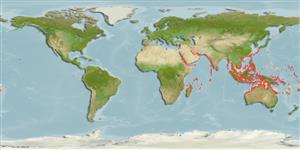Preferred temperature (Ref.
123201): 25 - 29.1, mean 28.2 °C (based on 1160 cells).
Phylogenetic diversity index (Ref.
82804): PD
50 = 0.6250 [Uniqueness, from 0.5 = low to 2.0 = high].
Bayesian length-weight: a=0.00037 (0.00016 - 0.00085), b=3.18 (2.99 - 3.37), in cm total length, based on LWR estimates for this (Sub)family-body shape (Ref.
93245).
ระดับชั้นอาหาร (Ref.
69278): 3.8 ±0.50 se; based on food items.
ความสามารถในการกลับคืนสู่ปกติ (Ref.
120179): ขนาดกลาง, เวลาต่ำสุดที่จะทำให้ประชากรเพิ่มขึ้นเป็น 2 เท่าใช้เวลา 1.4 - 4.4 ปี (Preliminary K or Fecundity.).
Fishing Vulnerability (Ref.
59153): Low to moderate vulnerability (30 of 100).
Nutrients (Ref.
124155): Calcium = 55.7 [31.6, 107.3] mg/100g; Iron = 0.585 [0.354, 1.158] mg/100g; Protein = 18.3 [17.2, 19.4] %; Omega3 = 0.109 [0.066, 0.191] g/100g; Selenium = 37.2 [20.8, 75.0] μg/100g; VitaminA = 68.1 [25.0, 176.6] μg/100g; Zinc = 1.09 [0.77, 1.52] mg/100g (wet weight);
